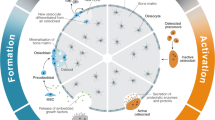Abstract
Analysis of the results of long-term investigations of bones in cosmonauts on board Mir orbital station(OS) and International Space Station (ISS) (n = 80) was performed. Theoretically predicted (evolutionary predefined) change in mass of different skeleton bones was found to be correlated (r = 0.904) with the position relative to Earth’s gravity vector. Vector dependence of bone loss results from local specificity of expression of bone metabolism genes, which reflects mechanical prehistory of skeleton structures in the evolution of Homo erectus. Genetic polymorphism is accountable for high individual variability of bone loss, which is attested by the dependence of bone loss rate on polymorphism of certain genetic markers of bone metabolism. The type of the orbital vehicle did not affect the individual-specific stability of the bone loss ratio in different segments of the skeleton. This fact is considered as a phenotype fingerprint of local metabolism in the form of a locus-specific spatial structure of distribution of non-collagen proteins responsible for position regulation of endosteal metabolism. Drug treatment of osteoporosis (n = 107) evidences that recovery rate depends on bone location; the most likely reason is different effectiveness of local osteotropic intervention into areas of bustling resorption.
Similar content being viewed by others
References
Alberts, B., Bray, D., Lewis, J., et al., Molecular Biology of the Cell, New York: Garland Publications, 1994.
Baranov, V.S., Baranova, E.V., Ivashchenko, T.E., et al., Genom cheloveka i geny “predraspolozhennosti”: Vvedenie v prediktivnuyu meditsinu (Human Genome and Genes of “Predisposition”: Introduction to Predictive Medicine), St. Petersburg, 2000.
Korzhuev, P.A., Evolyutsiya, gravitatsiya, nevesomost’ (Evolution, Gravity, and Microgravity), Moscow, 1971.
Kornilov, N.V. and Avrunin, A.S., Adaptatsionnye protsessy v organakh skeleta (Adaptation Processes in Skeleton Organs), St. Petersburg, 2001.
Oganov, V.S., Kostnaya sistema, nevesomost’ i osteoporoz (Bone System, Microgravity, and Osteoporosis), Moscow, 2003.
Oganov, V.S., Baranov, V.S., Kabitskaya, O.E., et al., Analysis of polymorphism of genes of bone metabolism and assessment of the risk of development of osteopenia in cosmonauts, Kosm. Biol. Aviakosm. Med., 2010, vol. 44, no. 3, p. 18.
Oganov, V.S. and Bogomolov, V.V., Bone system of humans in microgravity: Review of results of studies, hypotheses, and possibility of predicting the state in long-duration (interplanetary) missions, Kosm. Biol. Aviakosm. Med., 2009, vol. 43, no. 1, p. 3.
Oganov, V.S. and Shnaider, V.S., Bone system, in Kosmicheskaya biologiya i meditsina, vol. 3, book 1: Chelovek v kosmicheskom polete (Space Biology and Medicine, vol. 3, book 1: Humans in Space Flight), Moscow, 1997, p. 421.
Tairbekov, M.G., Klimovitskii, V.Ya., and Oganov, V.S., Role of gravity force in evolution of living systems: Biomechanical and energetic aspects, Izv. Akad. Nauk Ser. Biol., 1997, no. 5, p. 517.
Bonuchi, E. and Silvestrini, G., Ultrastructure of organic matrix of embryonic avian bone after en bloc reaction with various electron-dense “stains,” Acta Anat., 1996, vol. 156, no. 1, p. 22.
Carter, D.R., Wong, M., and Orr, T.E., Musculoskeletal ontogeny, phylogeny and functional adaptation, in Proc. of the NASA Symp. on the Influence of Gravity and Activity on Muscle and Bone, J. Biomechanics, 1991, vol. 24, suppl. 1, p. 3.
Kanis, J.A., Assessment of fracture risk and its application to screening for postmenopausal osteoporosis: synopsis of a WHO report. WHO Study Group, Osteoporos. Int., 1994, no. 4, p. 368.
Sibonga, J.D., Evans, H.J., Sung, H.G., et al., Recovery of spaceflight-induced bone loss: bone mineral density after long-duration missions as fitted with an exponential function, Bone, 2007, vol. 41, p. 973.
Vico, L., Lafage-Proust, M.-H., Collet, Ph., et al., Effects of space flight on bone of cosmonauts: does it lead to a definite bone deficiency?, International Scientific Cooperation on Board Mir, Lion, France, 2001, p. 189.
Author information
Authors and Affiliations
Corresponding author
Additional information
Original Russian Text © V.S. Oganov, I.A. Skripnikova, V.E. Novikov, A.V. Bakulin, O.E. Kabitskaya, L.M. Murashko, 2011, published in Aviakosmicheskaya i Ekologicheskaya Meditsina, 2011, Vol. 45, No. 4, pp. 16–21.
Rights and permissions
About this article
Cite this article
Oganov, V.S., Skripnikova, I.A., Novikov, V.E. et al. Characteristics of local human skeleton responses to microgravity and drug treatment for osteoporosis in clinic. Hum Physiol 40, 762–766 (2014). https://doi.org/10.1134/S0362119714070184
Received:
Published:
Issue Date:
DOI: https://doi.org/10.1134/S0362119714070184



